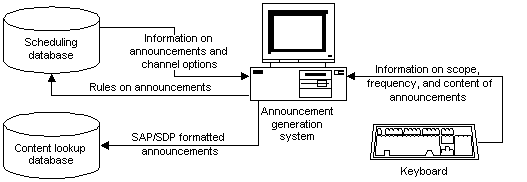
[This is preliminary documentation and subject to change.]
Not only does a broadcast need to be scheduled, but its announcement strategy needs to be determined, and its announcement text specified.
Typically, two types of announcement are available for every broadcast: a global announcement and a local announcement. A global announcement is usually issued infrequently over a broad range of tuning space, so as to alert client machines that a given content file will be broadcast over a given channel at a given time.
A local announcement, on the other hand, is usually sent frequently for a short period before a broadcast occurs, over the same channel on which the broadcast will occur. Its purpose is to alert a client that the broadcast is imminent and to provide any last-minute tuning information that may be needed.
Both types of announcement must be formatted as Session Announcement Protocol (SAP)/Session Description Protocol (SDP) pairs
The following diagram illustrates an announcement generation system. For more information on the use of a scheduling database, see Scheduling Broadcasts; for more information on the use of a content lookup database, see Storing and Cataloging Content Data.

An announcement generation system should enable an operator to choose the timing and frequency of both global and local announcements, to specify associated Internet Protocol (IP) addresses for each type of announcement, and to determine the content of each type of announcement. This information can then be stored in the content lookup database in SAP/SDP format, ready to use.
For more information on how Broadcast Architecture works with announcements, see Announcement Listener.